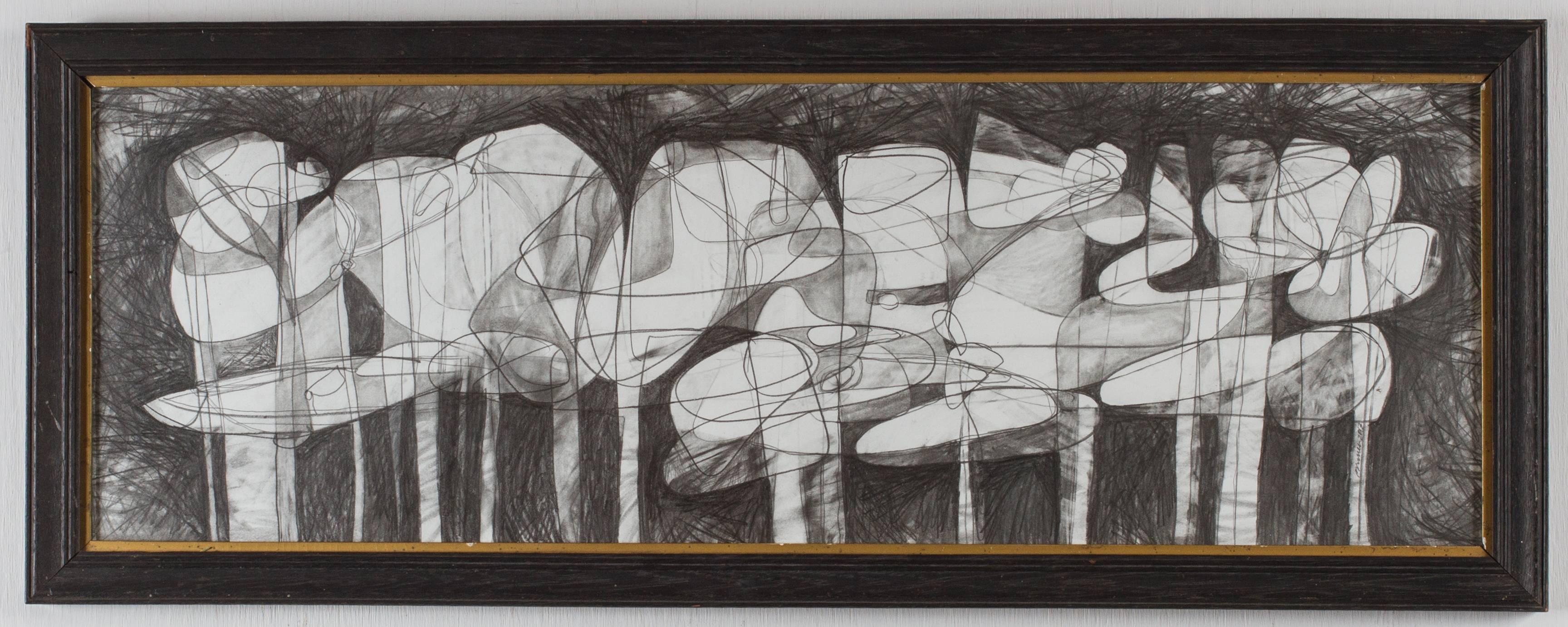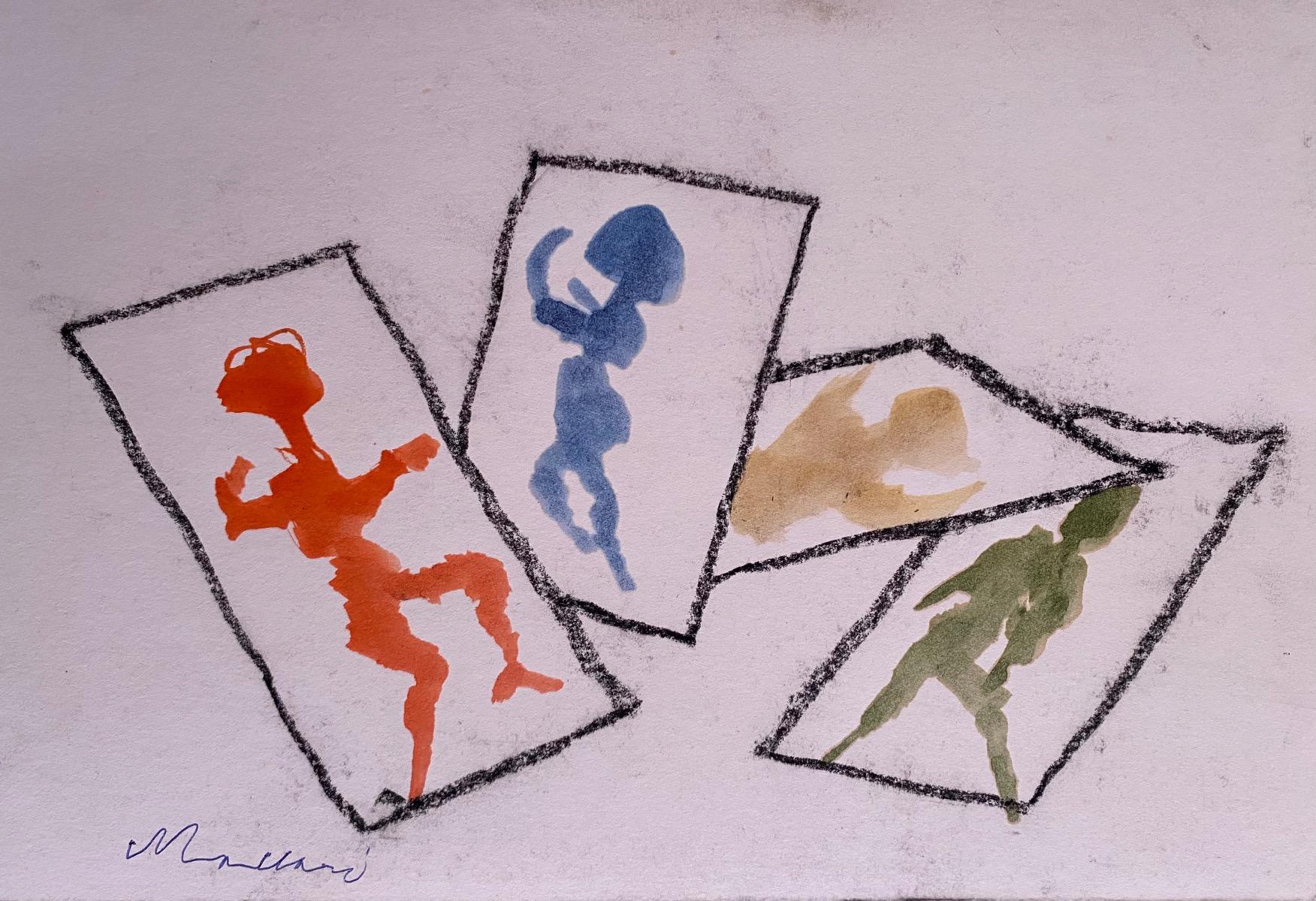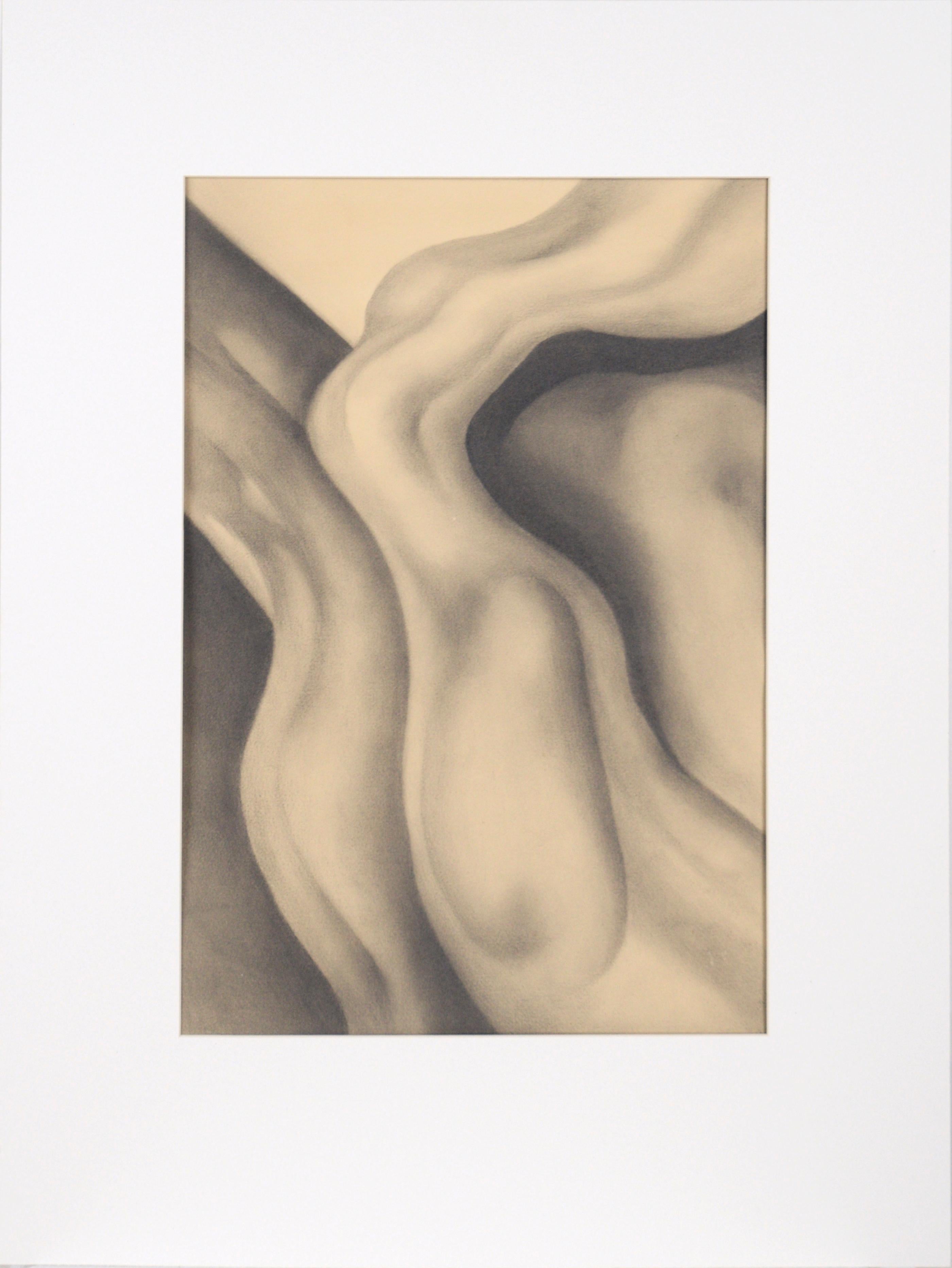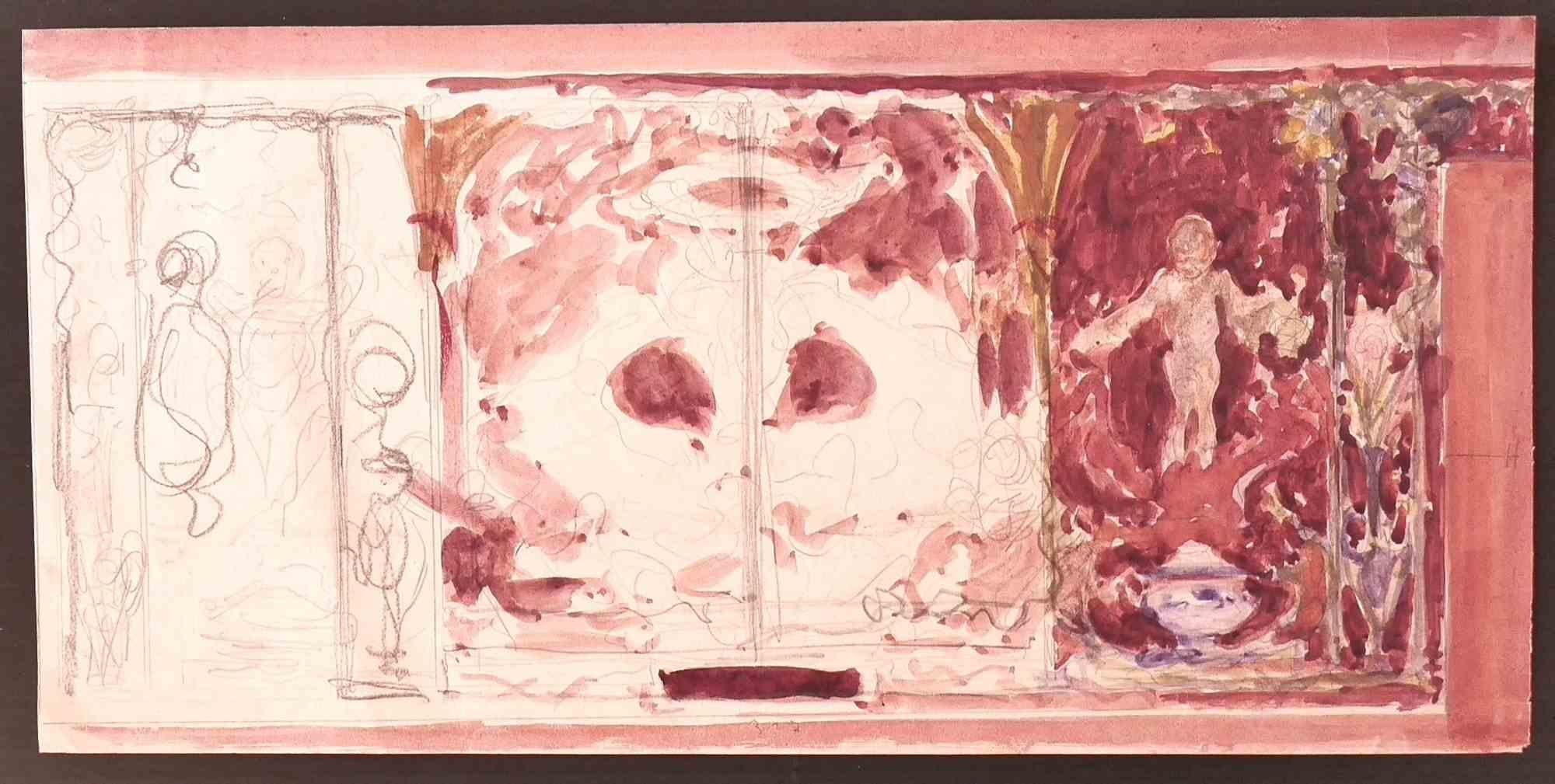Items Similar to Figures of Men - Drawing by Henri Félix Emmanuel Philippoteaux- Mid-19th Century
Want more images or videos?
Request additional images or videos from the seller
1 of 2
Henri Félix Emmanuel PhilippoteauxFigures of Men - Drawing by Henri Félix Emmanuel Philippoteaux- Mid-19th CenturyMid-19th Century
Mid-19th Century
About the Item
Figures of Men is a Pencil Drawing realized by Henri Félix Emmanuel Philippoteaux.
The little artwork is in good condition, included a white cardboard passpartout (37.5x54.5 cm).
No Signature, Stamp signed on the back of the yellowed paper.
Henri Félix Emmanuel Philippoteaux (3 April 1815, Paris – 8 November 1884, Paris) was a French artist and illustrator, known primarily as a battle painter. He was born in Paris, France, studied art at the studio of Léon Cogniet, and first exhibited his work at the Paris Salon of 1833.
- Creator:Henri Félix Emmanuel Philippoteaux (1815 - 1884, French)
- Creation Year:Mid-19th Century
- Dimensions:Height: 4.53 in (11.5 cm)Width: 7.09 in (18 cm)Depth: 0.08 in (2 mm)
- Medium:
- Movement & Style:
- Period:
- Framing:Framing Options Available
- Condition:Insurance may be requested by customers as additional service, contact us for more information.
- Gallery Location:Roma, IT
- Reference Number:
About the Seller
4.9
Platinum Seller
These expertly vetted sellers are 1stDibs' most experienced sellers and are rated highest by our customers.
1stDibs seller since 2017
6,757 sales on 1stDibs
Typical response time: 2 hours
- ShippingRetrieving quote...Ships From: Grasse, France
- Return PolicyA return for this item may be initiated within 14 days of delivery.
More From This SellerView All
- Shadows - Original Pencil and Watercolor by Mino Maccari - 1965By Mino MaccariLocated in Roma, ITShadows is an original modern artwork realized the 1965s by the Italian artist Mino Maccari (Siena, 1898 - Rome, 1989). Original pencil and watercolor drawing on Ivory cardboard. ...Category
1960s Modern Abstract Drawings and Watercolors
MaterialsWatercolor, Pencil
- Composition - Original Drawing - Mid-20th CenturyLocated in Roma, ITComposition is an original Drawing in Pencil and watercolor realized by an anonymous artist in the mid-20th Century. Good Conditions. The artwork is depicted through strong strokes...Category
Mid-20th Century Modern Abstract Drawings and Watercolors
MaterialsPencil, Watercolor
- The Church - Drawing By Reynold Arnould - 1970Located in Roma, ITThe Church is a Pencil Drawing realized by Reynold Arnould (Le Havre 1919 - Parigi 1980). Good condition on a white paper. No signature. Reynold Arnould was born in Le Havre, Fr...Category
1970s Modern Abstract Drawings and Watercolors
MaterialsPaper, Pencil
- Abstract Composition - Original Drawing by Maurice André - Mid-20th CenturyLocated in Roma, ITAbstract Composition is an original Ink and Watercolor drawing on paper applied realized by Maurice André in the Mid-20th Century. Good conditions. Han...Category
1950s Modern Abstract Drawings and Watercolors
MaterialsPencil, Watercolor
- Aenea and Dido - Original Pencil Drawing by Alberto Savinio - 1931By Alberto SavinioLocated in Roma, ITEnea e Didone (per Raffaele Carrieri) is a pencil drawing on paper, realized by Alberto Savinio in 1931, hand-signed and inscribed. Hand signed dedication to the italian writer and poet Raffaele Carrieri. Certificate of authenticity by Ruggero Savinio...Category
1930s Figurative Drawings and Watercolors
MaterialsPencil
- Trento - Bondone Corsa in Salita - Original Drawing by Fortunato Depero - 1928By Fortunato DeperoLocated in Roma, ITHand signed lower right: “F. Depero”. Certificate of authenticity by the Archive of Fortunato Depero. There are different versions of drafts that the Italian artist Fortunato Depero realized before the final Collage poster...Category
1920s Futurist Abstract Drawings and Watercolors
MaterialsPaper, Pencil, Color Pencil
You May Also Like
- Fourteen Ideas for Sculpture - 20th Century, Watercolour on paper by Henry MooreBy Henry MooreLocated in London, GBPencil, wax crayon, watercolour wash, pen and ink, crayon on cream medium weight wove Signed with pen and ink lower left 'Moore/39'Category
1930s Modern Abstract Drawings and Watercolors
MaterialsCrayon, Ink, Watercolor, Pencil
- Waterlilies #20 (Modern, Abstract Cubist Style Horizontal Landscape Drawing)By David Dew BrunerLocated in Hudson, NYgraphite on paper in vintage black wood frame 15 x 40 inches The contemporary, graphite work on paper is drawn in an abstracted, kinetic style where the artist drew continuous lines to portray a horizon of waterlilies in a landscape, creating a shard-like effect with great movement and speed. Sweeping lines of graphite arch and intersect to form abstracted circular standing flowers. The white cubist style flowers are contrasted against heavy, cross hatching lines of graphite. The artist fit the original drawing in a vintage brown wooden frame, measuring 15 x 40 inches. The frame exhibits some wear consistent with age, which is intentional by the artist. About the artist: A recent visit to David Dew Bruner’s train depot converted artist studio in Valatie, NY confirmed that the man does not sleep. Nor has he entirely put to rest the various series of graphite drawings on paper presented in a stunning array of mid-century and antique frames that were exhibited at the gallery last year. The still lives and figures inspired by artists like Velasquez, Morandi, and Lindner are morphing on a continuum of brilliance; the highly graphic influences of the Italian futurists like Giacomo Balla and Marcel du Champs, as well as the more obscure English Vortex movement have taken hold of Bruner’s intuitive approach to design as he channels it into his own drawings. The series of Infanta figures are emboldened with a new perspective and scaled up in size. A recent series of Arcs reference the gestural abstract shapes prevalent in the aesthetic of the Russian Constructivists. These works explore depth, movement, space and repetition that is more about design than reference. Bruner tastefully pairs drawings with a vintage frame from his collection, refashioning mirror frames from the 1960s or hand painting an antique Italian...Category
2010s Modern Abstract Drawings and Watercolors
MaterialsPaper, Graphite
- Surrealistic flower - Original Colour Pencil DrawingBy André MassonLocated in Paris, FRAndré Masson (1896-1987) Surrealistic flower Original colour pencil drawing Signed with the artist's stamp on the back (see photo) On 30.5 x 29 cm tracing paper (11.8 x 11.4 inche...Category
Mid-20th Century Modern Still-life Drawings and Watercolors
MaterialsPencil, Carbon Pencil
- Biomorphic AbstractLocated in Soquel, CAFlowing, organic abstract by Unger (20th Century). Several biomorphic shapes are flowing around each other, rendered in high-contrast shading. Signed and dated "Unger, 1975" on vers...Category
1970s Modern Abstract Drawings and Watercolors
MaterialsPencil, Postcard
- 'Still Life with Strings', Italian School (circa 1940s)Located in London, GB'Still Life with Strings', ink and pencil on paper, from the Italian School of artists (circa 1940s). This gallery acquired this artwork with two similar works for which this one may...Category
1940s Modern Abstract Paintings
MaterialsPaper, Ink, Pencil
- Two Wood Ducks on a Flowering BranchBy Joseph StellaLocated in New York, NYJoseph Stella was a visionary artist who painted what he saw, an idiosyncratic and individual experience of his time and place. Stella arrived in New York in 1896, part of a wave of Italian immigrants from poverty-stricken Southern Italy. But Stella was not a child of poverty. His father was a notary and respected citizen in Muro Locano, a small town in the southern Appenines. The five Stella brothers were all properly educated in Naples. Stella’s older brother, Antonio, was the first of the family to come to America. Antonio Stella trained as a physician in Italy, and was a successful and respected doctor in the Italian community centered in Greenwich Village. He sponsored and supported his younger brother, Joseph, first sending him to medical school in New York, then to study pharmacology, and then sustaining him through the early days of his artistic career. Antonio Stella specialized in the treatment of tuberculosis and was active in social reform circles. His connections were instrumental in Joseph Stella’s early commissions for illustrations in reform journals. Joseph Stella, from the beginning, was an outsider. He was of the Italian-American community, but did not share its overwhelming poverty and general lack of education. He went back to Italy on several occasions, but was no longer an Italian. His art incorporated many influences. At various times his work echoed the concerns and techniques of the so-called Ashcan School, of New York Dada, of Futurism and, of Cubism, among others. These are all legitimate influences, but Stella never totally committed himself to any group. He was a convivial, but ultimately solitary figure, with a lifelong mistrust of any authority external to his own personal mandate. He was in Europe during the time that Alfred Stieglitz established his 291 Gallery. When Stella returned he joined the international coterie of artists who gathered at the West Side apartment of the art patron Conrad Arensberg. It was here that Stella became close friends with Marcel Duchamp. Stella was nineteen when he arrived in America and studied in the early years of the century at the Art Students League, and with William Merritt Chase, under whose tutelage he received rigorous training as a draftsman. His love of line, and his mastery of its techniques, is apparent early in his career in the illustrations he made for various social reform journals. Stella, whose later work as a colorist is breathtakingly lush, never felt obliged to choose between line and color. He drew throughout his career, and unlike other modernists, whose work evolved inexorably to more and more abstract form, Stella freely reverted to earlier realist modes of representation whenever it suited him. This was because, in fact, his “realist” work was not “true to nature,” but true to Stella’s own unique interpretation. Stella began to draw flowers, vegetables, butterflies, and birds in 1919, after he had finished the Brooklyn Bridge series of paintings, which are probably his best-known works. These drawings of flora and fauna were initially coincidental with his fantastical, nostalgic and spiritual vision of his native Italy which he called Tree of My Life (Mr. and Mrs. Barney A. Ebsworth Foundation and Windsor, Inc., St. Louis, illus. in Barbara Haskell, Joseph Stella, exh. cat. [New York: Whitney Museum of American Art, 1994], p. 111 no. 133). Two Wood Ducks...Category
20th Century American Modern Still-life Drawings and Watercolors
MaterialsColor Pencil
Recently Viewed
View AllMore Ways To Browse
The Paris Salons
19th Century Figures
Midcentury Abstract Drawing
Drawing Men
Mid Century Mens
19th Century Mens
Men Figures
Mens Artwork
Henri Studios
Watercolor Men
Antique Abstract Paintings
Antique Abstract Painting
Abstract Antique Painting
Watercolor Battle
19th Century French Pencil Drawing
Leon Little
Antique Abstract Watercolors
Antique Abstract Drawings




